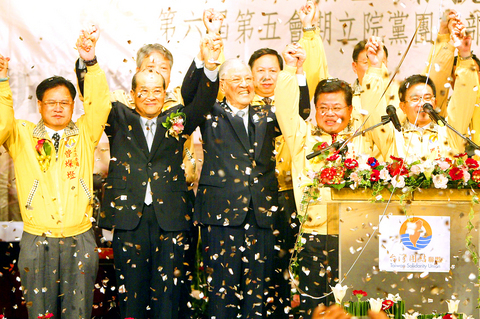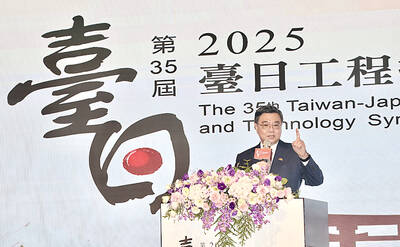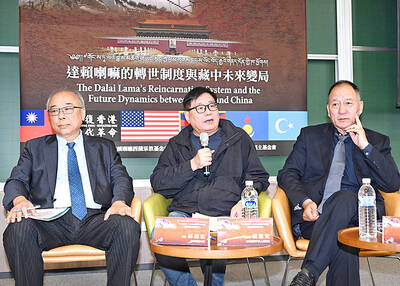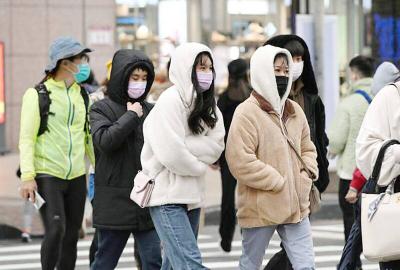Huang Kun-huei (
In his inauguration speech, Huang said he was mulling changing the party's name and modifying the party's platform to reflect its move from the left toward the center.
He pledged to prioritize the welfare of the nation's middle class and minorities.

PHOTO: CNA
Comparing the Democratic Progressive Party and the Chinese Nationalist Party (KMT) to the two elder brothers in a family, Huang said that the TSU, like the third child in the family, would work to serve as a "middle force" that resolves the conflict between the "two big parties with their extreme stances."
"TSU offers a better, third choice for the people," Huang added. "We will let voters understand that the conflict between the pan-green and the pan-blue camps has to stop to ensure Taiwan's survival and development."
Huang denied, however, that this meant the party was going to tone down its promotion of Taiwanese independence.
"It is a firm Taiwan-centered approach, rather than a less radical Taiwan-independence approach," he said, adding that Taiwan does not need to declare independence because it is an independent sovereignty.
"The TSU will lead the people by promoting the values of Taiwan-ese consciousness, democracy, freedom, social justice and integrity, awaken the people with our passion and keep our promises to the people by action," he said.
These are the reasons why the party exists, he added.
Huang said that the TSU was always open to cooperation and negotiation and would lend its full support to any party in the legislature as long as the proposed bills were beneficial to Taiwanese.
"If the proposal or bill were negative to Taiwan's develop-ment, we will not support it even if it were proposed by President Chen Shui-bian (陳水扁)," Huang said.

ALIGNED THINKING: Taiwan and Japan have a mutual interest in trade, culture and engineering, and can work together for stability, Cho Jung-tai said Taiwan and Japan are two like-minded countries willing to work together to form a “safety barrier” in the Indo-Pacific region, Premier Cho Jung-tai (卓榮泰) yesterday said at the opening ceremony of the 35th Taiwan-Japan Modern Engineering and Technology Symposium in Taipei. Taiwan and Japan are close geographically and closer emotionally, he added. Citing the overflowing of a barrier lake in the Mataian River (馬太鞍溪) in September, Cho said the submersible water level sensors given by Japan during the disaster helped Taiwan monitor the lake’s water levels more accurately. Japan also provided a lot of vaccines early in the outbreak of the COVID-19 pandemic,

Kaohsiung Mayor Chen Chi-mai (陳其邁) on Monday announced light shows and themed traffic lights to welcome fans of South Korean pop group Twice to the port city. The group is to play Kaohsiung on Saturday as part of its “This Is For” world tour. It would be the group’s first performance in Taiwan since its debut 10 years ago. The all-female group consists of five South Koreans, three Japanese and Tainan’s Chou Tzu-yu (周子瑜), the first Taiwan-born and raised member of a South Korean girl group. To promote the group’s arrival, the city has been holding a series of events, including a pop-up

TEMPORAL/SPIRITUAL: Beijing’s claim that the next Buddhist leader must come from China is a heavy-handed political maneuver that will fall flat-faced, experts said China’s requirement that the Dalai Lama’s reincarnation to be born in China and approved by Beijing has drawn criticism, with experts at a forum in Taipei yesterday saying that if Beijing were to put forth its own Dalai Lama, the person would not be recognized by the Tibetan Buddhist community. The experts made a remarks at the two-day forum hosted by the Tibet Religious Foundation of His Holiness the Dalai Lama titled: “The Snow Land Forum: Finding Common Ground on Tibet.” China says it has the right to determine the Dalai Lama’s reincarnation, as it claims sovereignty over Tibet since ancient times,

Temperatures in some parts of Taiwan are expected to fall sharply to lows of 15°C later this week as seasonal northeasterly winds strengthen, the Central Weather Administration (CWA) said today. It is to be the strongest cold wave to affect northern Taiwan this autumn, while Chiayi County in the southwest and some parts of central Taiwan are likely to also see lower temperatures due to radiational cooling, which occurs under conditions of clear skies, light winds and dry weather, the CWA said. Across Taiwan, temperatures are to fall gradually this week, dropping to 15°C to 16°C in the early hours of Wednesday